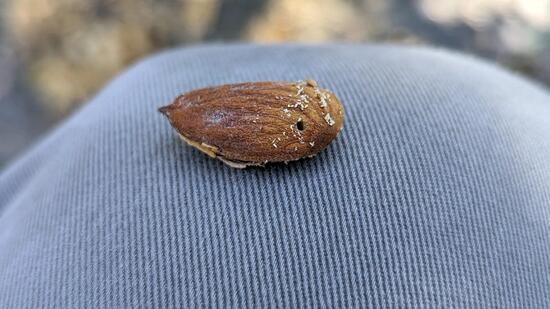
holes that they bore into the kernel. Since the beetles overwinter in mummy nuts,
winter sanitation is critical to their control. HOUSTON WILSON/UC RIVERSIDE
If ever there were not enough reasons for tree nut farmers to be diligent about winter sanitation, they now have one more with the discovery of a new invasive beetle that overwinters in mummy nuts.
This new beetle – Carpophilus truncatus (Nitidulidae) – is a known pest of almonds in Australia, where they have been dealing with infestations for almost a decade now. More recently there have been reports of similar Carpophilus beetles infesting walnuts in Argentina and Italy.
Now we can add California to that list. Beetle infestations were observed in almond and pistachio orchards earlier this fall, and specimens collected by the University of California Cooperative Extension were subsequently confirmed as Carpophilus truncatus by the California Department of Food and Agriculture, according to Houston Wilson, associate Cooperative Extension specialist in the Department of Entomology at the University of California, Riverside. So far, the presence of the beetle has been confirmed from orchards in Stanislaus, Merced, Madera, and Kings counties. Wilson and colleagues are now conducting a broader regional survey of orchards throughout the rest of the San Joaquin Valley.
The insect may already be widespread, as the damage it causes has been seen for several years in the San Joaquin Valley, according to Jhalendra Rijal, entomologist and area integrated pest management advisor with the University of California Cooperative Extension in Stanislaus County. “It has likely been here for a few years based on the damage we’ve seen, but it may have been confused for another insect,” Rijal said.
“While there are other species of Carpophilus that we sometimes see in orchards, this new species, Carpophilus truncatus, is the only one that directly attacks the nuts – and so of course we’re especially concerned about it,” said Wilson.
Research from Australia determined that this pest overwinters in unharvested mummy nuts. In the summer adults move into the tree canopy, where they deposit eggs onto the developing new crop nuts. The beetle larvae that emerge then bore into the nut, leaving a unique oval-shaped hole surrounded by a pile of fine frass.
Pest is unfamiliar
Little is known about the beetle in California, Rijal said. Because it is so new, he could not say whether existing insecticides or biocontrol strategies can effectively control it. Wilson and David Haviland, entomology farm advisor for Kern County, are now reaching out to colleagues in Australia to learn more about their experience and recommendations for managing this pest. In addition to the regional survey, Wilson is working with Rijal and Haviland to pull together key data on Carpophilus truncatus, including how to correctly identify, monitor and manage it. That information will be released soon as they put it all together.
“In the meantime, I can’t emphasize enough the importance of crop sanitation for controlling this new pest” said Wilson, “Like navel orangeworm, this new Carpophilus beetle overwinters in the mummy nuts, and so crop sanitation is fundamental to control it.” This means all unharvested nuts need to be removed from trees and destroyed to reduce overwintering populations of both NOW and the new Carpophilus truncatus beetle.
“In a year like this, with such high levels of NOW damage, we’ve already been stressing the importance of winter sanitation with growers and PCAs,” Wilson continued. “Now, with the arrival of Carpophilus truncatus, orchard sanitation is exponentially more critical – whatever it takes, get out there and get it done.”